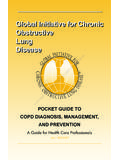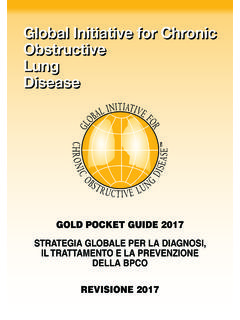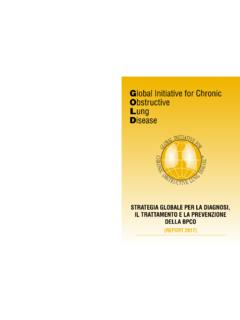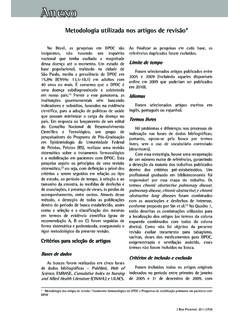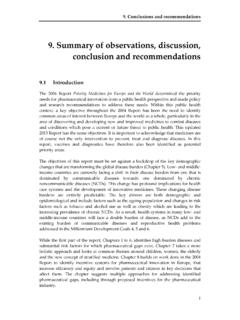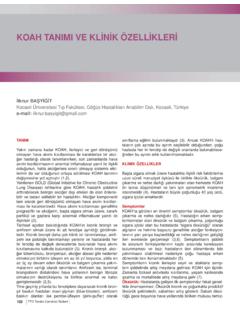Transcription of Global Initiative for Chronic Obstructive Lung Disease
1 Global STRATEGY FOR THE DIAGNOSIS, MANAGEMENT, AND PREVENTION OF Chronic Obstructive PULMONARY DISEASE2006 Global Initiative for ChronicObstructiveLungDiseaseCopyright 2006 MCR VISION, Rights ReservediGLOBAL Initiative FORCHRONIC Obstructive LUNG DISEASEGLOBAL STRATEGY FOR THE DIAGNOSIS, MANAGEMENT, AND PREVENTION OF Chronic Obstructive PULMONARY Disease (2006) 2006 Global Initative for Chronic Obstructive Lung DiseaseGlobal Strategy for the Diagnosis, Management, and Prevention ofChronic Obstructive Pulmonary Disease (2006)GOLD EXECUTIVE COMMITTEE*A. Sonia Buist, MD, ChairOregon Health & Science University Portland, Oregon, USAA ntonio Anzueto, MD (Representing the American Thoracic Society)University of Texas Health Science CenterSan Antonio, Texas, USAP eter Calverley, MDUniversity Hospital AintreeLiverpool, UK Teresita S. deGuia, MDPhilippine Heart CenterQuezon City, PhilippinesYoshinosuke Fukuchi, MD(Representing the Asian Pacific Society for Respirology)Tokyo, JapanChristine Jenkins, MDWoolcock Institute of Medical ResearchSydney, NSW, AustraliaNikolai Khaltaev, MD(Representing the World Health Organization)Geneva, SwitzerlandJames Kiley, PhD(Representing the National Heart, Lung, and Blood Institute,National Institutes of Health, Department of Health and Human Services) Bethesda, Maryland, USAAli Kocabas, MD Cukurova University School of MedicineBalcali, Adana, TurkeyMar Victorina L pez, MD(Representing the Latin American Thoracic Society)Montevideo, URUGUAYEwa Nizankowska-Mogilnicka, MDUniversity School of MedicineKrakow, PolandKlaus F.
2 Rabe, MD, PhD Leiden University Medical Center Leiden, The Netherlands Roberto Rodriguez Roisin, MDHospital ClinicBarcelona, Spain Thys van der Molen, MDUniversity of GroningenGroningen, The NetherlandsChris van Weel, MD(Representing the World Organization of Family Doctors(WONCA))University of NijmegenNijmegen, The NetherlandsGOLD SCIENCE COMMITTEE*Klaus F. Rabe, MD, PhD, ChairLeiden University Medical Center Leiden, The Netherlands A. G. Agusti, MD (Effective June 2006)Hospital Universitari Son DuretaPalma de Mallorca, SpainAntonio Anzueto, MD University of Texas Health Science CenterSan Antonio, Texas, USAP eter J. Barnes, MDNational Heart and Lung InstituteLondon, UKA. Sonia Buist, MDOregon Health & Science UniversityPortland, Oregon, USAP eter Calverley, MDUniversity Hospital AintreeLiverpool, UK Marc Decramer, MD (Effective June 2006)University HospitalLeuven, BelgiumYoshinosuke Fukuchi, MDPresident Asian Pacific Society for RespirologyTokyo, JapanPaul Jones, MD (Effective June 2006)St.
3 George's Hospital Medical SchoolLondon, UKii*Disclosure forms for GOLD Committees are posted on the GOLD Website, Rodriguez Roisin, MDHospital ClinicBarcelona, Spain Jorgen Vestbo, MD (Effective June 2006)Hvidovre University HospitalHvidovre, DenmarkJan Zielinski, MDInstitute of TB and Lung DiseasesWarsaw, PolandCHAPTER CONTRIBUTORSL eonardo Fabbri, MDUniversity of Modena & Reggio EmiliaModena, ItalyJames C. Hogg, MDSt. Paul s HospitalVancouver, British Columbia, CanadaChristine Jenkins, MDWoolcock Institute of Medical ResearchSydney, NSW, AustraliaEwa Nizankowska-Mogilnicka, MDUniversity School of MedicineKrakow, PolandSean Sullivan, MDUniversity of WashingtonSeattle, Washington, USAThys van der Molen, MDUniversity of GroningenGroningen, The NetherlandsChris van Weel, MDUniversity of NijmegenNijmegen, The NetherlandsREVIEWERSBart Celli, MDCaritas St. Elizabeth's Medical CenterBrighton, Massachusetts, Elliott, MDSt.
4 James's University HospitalWest Yorkshire, Kerstjens, MD, PhD University Medical Center Groningen Groningen, The Netherlands Peter Lange, MDHvidovre HospitalHvidovre, DenmarkCarlos M. Luna, MDPresident, ALATB uenos Aires, ArgentinaDennis Niewoehner, MDUniversity of MinnesotaMinneapolis, Minnesota, USAJim Reid, MDDunedin School of MedicineUniversity of Otago Dunedin, New ZealandSanjay Sethi, MDVAM edical ResearchBuffalo, New York, USAP eter Sterk, MDLeiden University Medical CenterLeiden, The NetherlandsGOLD NATIONAL LEADERS WHO SUBMITTED COMMENTSL orenzo Corbetta, MDUniversit di Firenze Firenze, ItalyMaia Gotua, MD, PhDCenter of Allergy & ImmunologyTbilisi, GeorgiaG rard Huchon, MDUniversity of ParisParis, FranceProf. Irusen South Africa Thoracic SocietyUniversity of StellenboschCape Town, South AfricaYousser Mohammad, MDTishreen University School of MedicineLattakia, SyriaJaromir Musil, PhDStanislav Kos, MD, PhDF.
5 Salajka, PhDVladimir Vondra, MD, PhDCzech Association Against COPDP rague, Czech RepublicVesna Petrovic, MDJUDAH Association for Asthma and COPDS erbiaiiiChronic Obstructive Pulmonary Disease (COPD) remainsa major public health problem. It is the fourth leadingcause of Chronic morbidity and mortality in the UnitedStates, and is projected to rank fifth in 2020 in burden of Disease caused worldwide, according to a study published by the World Bank/World Health , although COPD has received increasingattention from the medical community in recent years, itis still relatively unknown or ignored by the public as wellas public health and government officials. In 1998, in an effort to bring more attention to COPD, itsmanagement, and its prevention, a committed group ofscientists encouraged the US National Heart, Lung, andBlood Institute and the World Health Organization to formthe Global Initiative for Chronic Obstructive Lung Disease (GOLD).
6 Among the important objectives of GOLD are toincrease awareness of COPD and to help the millions ofpeople who suffer from this Disease and die prematurelyfrom it or its first step in the GOLD program was to prepare aconsensus report, Global Strategy for the Diagnosis,Management, and Prevention of COPD, which was published in 2001. The report was written by an ExpertPanel, which was chaired by Professor Romain Pauwelsof Belgium and included a distinguished group of healthprofessionals from the fields of respiratory medicine, epidemiology, socioeconomics, public health, and healtheducation. The Expert Panel reviewed existing COPD guidelines and new information on pathogenic mechanismsof COPD, bringing all of this material together in the consensus document. The present, newly revised documentfollows the same format as the original consensus report,but has been updated to reflect the many publications onCOPD that have appeared since 2001.
7 Since the original consensus report was published in2001, a network of international experts known as GOLDN ational Leaders has been formed to implement thereport s recommendations. Many of these experts haveinitiated investigations of the causes and prevalence ofCOPD in their countries, and developed innovativeapproaches for the dissemination and implementation of COPD management guidelines. We appreciate theenormous amount of work the GOLD National Leadershave done on behalf of their patients with COPD. In spite of the achievements in the five years since theGOLD report was originally published, considerable additional work is ahead of all of us if we are to controlthis major public health problem. The GOLD Initiative willcontinue to bring COPD to the attention of governments,public health officials, health care workers, and the general public, but a concerted effort by all involved inhealth care will be would like to acknowledge the work of the members ofthe GOLD Science Committee who prepared this revisedreport.
8 We look forward to our continued work with interested organizations and the GOLD National Leadersto meet the goals of this are most appreciative of the unrestricted educationalgrants from Altana, AstraZeneca, Boehringer Ingelheim,Chiesi, GlasoSmithKline, Mitsubishi Pharma Corporation,Nikken Chemicals, Co,. Ltd., Novartis, and Pfizer thatenabled development of this Sonia Buist, MDPortland, Oregon, USAC hair, GOLD Executive CommitteeivPREFACEI ntroduction ..1. Definition ..Key Points ..Definition ..Airflow limitation in COPDCOPD and Co-morbiditiesNatural History ..Spirometric Classification of Severity Stages of COPDS cope of the Report ..Asthma and COPD ..Pulmonary Tuberculosis and COPD ..References ..2. Burden of COPD ..Key Points ..Introduction ..Epidemiology ..Prevalence ..Morbidity ..Mortality ..Economic and Social Burden of COPD ..Economic Burden.
9 Social Burden ..References ..3. Risk Factors ..Key Points ..Introduction ..Risk Factors ..Genes ..Inhalational Exposures ..Tobacco smoke Occupational dusts and chemicalsIndoor air pollutionOutdoor air pollutionLung Growth and Development ..Oxidative StressGenderInfections ..Socioeconomic Status ..NutritionAsthmaReferences ..4. Pathology, Pathogenesis, and Pathophysiology ..Key Points ..Introduction ..Pathology ..PathogenesisInflammatory Cells ..Inflammatory Mediators ..OxidativeProtease-Antiprotease Imbalance Differences in Inflammation Between COPD and Asthma ..Pathophysiology ..Airflow Limitation and Air TrappingGas Exchange Abnormalities ..Mucus HypersecretionPulmonary HypertensionSystemic Features ..Exacerbations ..References ..5. Management of COPDI ntroduction ..Component 1: Assess and Monitor Disease ..Key Points ..Initial Diagnosis.
10 Assessment of Symptoms ..DyspneaCoughSputum productionWheezing and chest tightnessAdditional features in severe diseaseMedical History ..Physical Examination ..InspectionPalpation and percussionAuscultationMeasurement of Airflow Limitation ..Assessment of COPD Severity ..Additional Investigations .. Bronchodilator reversibility testingChest X-rayArterial blood gas measurementAlpha-1 antitrypsin deficiency screeningDifferential Diagnosis ..Ongoing Monitoring and Assessment Monitor Disease Progression andvTABLE OF CONTENTSD evelopment of ComplicationsPulmonary functionArterial blood gas measurement Assessment of pulmonary hemodynamicsDiagnosis of right heart failure or cor pulmonaleCT and ventilation-perfusion scanningHematocritRespiratory muscle functionSleep studiesExercise testingMonitor Pharmacotherapy andOther Medical Treatment ..Monitor Exacerbation History.










